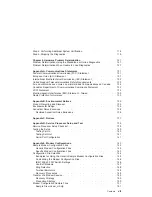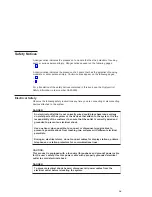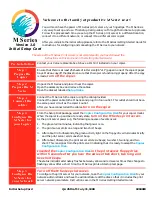
Note: For configurations only using 1 I/O board with no additional I/O drawers, only
the two DASD backplanes (allowing the installation of up to 8 disk drives) are
available.
v
Hardware Management Console (HMC) - The HMC consists of a display,
independent processor, keyboard, and mouse. The HMC is mandatory for all
systems. For more information on the use of logical partitioned systems, see the
“Partitioned System Overview”.
Partitioned System Overview
Partitioning enables users to configure a single computer into several independent
systems. Each of these systems, called
logical partitions, is capable of running
applications in its own independent environment. This independent environment
contains its own operating system, its own set of system processors, its own set of
system memory, and its own I/O adapters.
An affinity partition is a special type of logical partition in which processors and system
memory are allocated in a pre-defined way that may increase performance when
running some types of applications (memory is assigned to a processor that is in close
physical proximity to it).
The HMC allows you to perform many hardware management tasks for your managed
system, including configuring logical partitions. You can choose to operate your
managed system as a single server (called full system partitions), or you can choose to
run multiple partitions.
Partition Profiles
A profile defines a configuration setup for a managed system or partition. The HMC
allows you to create multiple profiles for each managed system or partition. You can
then use the profiles you created to start a managed system or partition in a particular
configuration.
A partition does not actually own any resources until it is activated; resource
specifications are stored within partition profiles. The same partition can operate using
different resources at different times, depending on the profile you activate.
When you activate a partition, you enable the system to create a partition using the set
of resources in a profile created for that partition. For example, a logical partition profile
might indicate to the managed system that its partition requires 3 processors, 2
gigabytes of memory, and I/O slots 6, 11, and 12 when activated.
You can have more than one profile for a partition. However, you can only activate a
partition with one profile at a time. Additionally, affinity partitions and logical partitions
cannot be active at the same time.
When you create a partition profile, the HMC shows you all the resources available on
your system. The HMC does not, however, verify if another partition profile is currently
using a portion of these resources. For example, the HMC might show 16 processors
on your system, but does not notify you that other partitions are using nine of them. You
Chapter 1. Introducing the
Eserver
pSeries 670
3
Summary of Contents for Eserver pSeries 670
Page 1: ...pSeries 670 User s Guide SA38 0614 00 ERserver IBM...
Page 2: ......
Page 3: ...pSeries 670 User s Guide SA38 0614 00 ERserver IBM...
Page 14: ...xii Eserver pSeries 670 User s Guide...
Page 22: ...6 Eserver pSeries 670 User s Guide...
Page 28: ...12 Eserver pSeries 670 User s Guide...
Page 88: ...72 Eserver pSeries 670 User s Guide...
Page 136: ...120 Eserver pSeries 670 User s Guide...
Page 150: ...134 Eserver pSeries 670 User s Guide...
Page 154: ...138 Eserver pSeries 670 User s Guide...
Page 158: ...142 Eserver pSeries 670 User s Guide...
Page 188: ...172 Eserver pSeries 670 User s Guide...
Page 194: ...178 Eserver pSeries 670 User s Guide...
Page 197: ......
















































